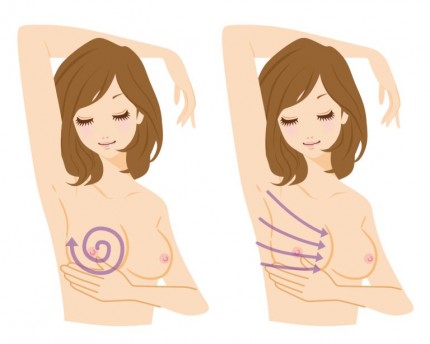Breast self-examination should be performed every month after menstruation (5-12th day of the cycle). To do that, one must stand naked in front of the mirror and evaluate several factors, such as form, symmetry and skin health. Then, one should raise their right hand above their head, and, using one’s left hand, check for lumps in breast (frontal, side, nipple and periphery) and armpit area. This should be repeated with the left side of the body. Self-examination should be performed slowly, using one’s fingertips.
If any changes in breast or skin, or any lumps are found, one must contact their doctor immediately. If one is performing the self-examination regularly, it is possible to learn how to perform the tests effectively and to detect the changes with greater accuracy, and thus to inform their doctors on time. However, for women over the age of 30, it is is highly recommended to pay a visit to a doctor’s office for a yearly breast ultrasound and check-up. Yearly check-ups should start at the age of 25 if there were cases of breast cancer in the female patient's family. Additionally, at the age of 40 and older, mammogram testing should be performed once or twice a year.
Breasts are one of the few organs that change throughout the person's lifespan. Starting out only as a gland, a breast can go through multiple periods of atrophy and growth over the years. Breast growth starts at the age of 10, also known as the early reproductive period. After reaching full maturity, regular changes in breast gland should begin. These changes are related to the menstrual cycle, pregnancy and lactation and are known as the reproductive period. At the age of 30, however, this process might start reversing, also known as involution. Involution process might lead to fibrosis, microcysts and adenosis, while gland tissue is replaced by fatty tissue. Natural hormone shifts in female body is the main cause of involution. It can lead to pain, lumps in breast area and inflamation. It is crucial to know that some of these symptoms can develop in teenage years, namely fibroadenoma, phyllodes tumour and fibrocystic breast disease.
- Fibroadenoma are painless lumps in breast tissue. It is widely thought they are caused by hormone process. 9 times out of 10 they are considered benign. However, there is a 1/10 chance of them appearing on both breasts at the same time. In many cases, fibroadenoma just disappear by themselves.
- Although cysts can appear at any age, the chance increases during the involution period and during menopause. Cysts are sac-like pockets of liquid that can appear in one or both breasts. Cysts come in varying sizes, starting from barely noticeable to multiple centimeters long. Cysts might get painful just before menstruation. Cysts might turn cancerous, however that happens in extremely rare cases. The most common treatment is puncturing the breast and draining the cyst fluid. If the cyst fluid is clear and bloodless, the cyst is considered benign and no other tests are required. However, if the cyst does not shrink after drainage, some additional tests are required to discern if the cyst is not, in fact, a tumour.
- Lipoma is fatty tissue encased in a capsule. Since developing lipoma can be painful, it is a very frightening experience, because they can be mistaken for a more serious disease. A mammogram or ultrasound can reveal and confirm that lipoma is indeed benign and could be fixed via surgery. Surgery, however, is not mandatory, and should only be performed on the patient's own volition.
- Papilloma growths can also occur in breasts. The most common symptom is bloody discharge from the nipples. Since it is difficult to discern whether the papilloma are benign or cancerous, the most common solution is surgery.
Breast pain, also known as mastalgia or mastodynia, is one of the most common reasons for visiting a doctor. A lot of women after feeling pain for the first time suspect that it is a symptom of a serious disease, and for a good reason. According to the current data, at least one in two to three women have felt or feel breast pain.
Cyclical pain depends on one's menstrual cycle. It is generally felt a week before menstruation and a lot of times it can predict premenstrual syndrome. Non-cyclical pain, on the other hand, is not related to the menstrual cycle. It is more common in women of older age. This pain might be felt in one or both breasts and can be a symptom of fibroadenoma, lipoma, cyst or even cancer. Mastalgia and mastodynia can pass by themselves, without any intervention. However, if one wants to stay reassured, it is highly recommended to visit a specialist. Mastalgia can be treated by herbal supplements. Some of these supplements can help with mastalgia recovery and benign lump treatment.
A lot of women might get frightened once they find lumps in the breast area. However, a lot of them (up to 90%) might be benign and occur naturally. On the other hand, it is crucial to understand that lumps might be one of the possible symptoms of upcoming breast cancer. Although a lot of growths are benign, it is highly recommended to visit a doctor if one notices a new lump. By doing that, it is possible to diagnose a tumour in its earliest stages and remove it before it causes any significant harm. Because of that, it is suggested to perform breast self-examination each month for you and women in your family. This way it is possible to avoid serious health issues before it is too late.
Source: https://gamtosgrozioformule.lt
